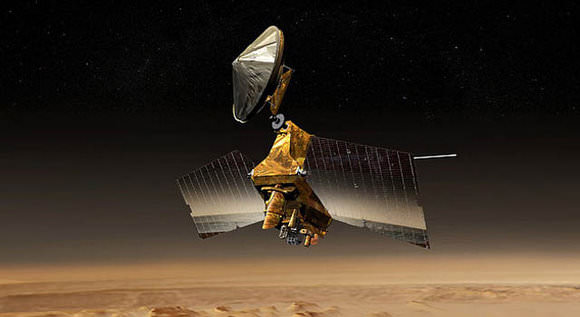[/caption]
NASA’s Mars Reconnaissance Orbiter put itself into a safe mode Wednesday morning, Aug. 26, for the fourth time this year. While in safe mode, the spacecraft can communicate normally with Earth, but aborts its scheduled activities, and awaits further instructions from ground controllers. “We hope to gain a better understanding of what is triggering these events and then have the spacecraft safely resume its study of Mars by next week,” said MRO Project Manager Jim Erickson.
Engineers have begun the process of diagnosing the problem prior to restoring the orbiter to normal science operations, a process expected to take several days. They will watch for engineering data from the spacecraft that might aid in identifying the cause of event and possibly of previous ones.
A possible cause for the frequent anomalies is cosmic ray hits. But the spacecraft has reacted differently with the various safe mode entries. The orbiter spontaneously rebooted its computer Wednesday, as it did in February and June, but did not switch to a redundant computer, as it did in early August.
To help in investigating a root cause of the three previous anomalies, engineers had programmed the spacecraft to frequently record engineering data onto non-volatile memory. That could give an improved record of spacecraft events leading up to the reboot.
MRO has been in Mars orbit since 2006, and has returned more data than all other current and past Mars missions combined.
Source: JPL


The MRO probably uses Windows XP (SP3); every time I am in the middle of doing something on my PC, it demands: Windows needs to shut down in order for the updates to take effect.
To which I respond: NOT NOW, KATO!
Maybe MRO has been stung by the Green Hornet 🙂 . My Windows Vista Home Premium (SP3) does the same thing!
On a more serious note, I recently came across an article that describes the OS used for MRO and many other space probes (thanks to Carnival of Space #117). A description of VxWorks MILS Platform 2.0 by the designer can be found here: http://orbitalhub.com/?p=554 . Of course, while NASA doesn’t use Windows products as the prime OS for any of its major deep space missions, I have noticed Windows screensavers on several of the laptops aboard the ISS and the Shuttle (for convenience, maybe?).
There’s a simple truth : if you don’t hook up windows to the internet, it performs rather well.
It is true, many laptops and computers in the ISS have windows running on it (some of them still windows 95), but be assured, none of these computers are performing any critical tasks. They serve merely for the astronauts to send a mail to ground.
If I were you I wouldn’t let Windows update itself. Do it manually (Windows just informs me, when new critical updates are available) and you won’t have such problems, don’t you think? 😉
I run linux! 🙂
Although I don’t know about running Linux on spacecraft. I wonder if QNX was considered. It’s used at Canadian nuclear power plants.
@ DrFlimmer,
Well, most of the time, the auto updates are not a problem, but the critical ones always seem to occur at awkward moments — like when freakin’ kids, in the back of the car, need to go to the john, just when you’re cruising nicely on the autobahn and you’re miles away from the nearest bloody service station!
@ ND,
I wonder what OS was being used when Chernobyl went SNAFU.
IVAN3MAN,
I don’t think they had one. It was all wetware based I presume, thus the human error.
IIRC it was *experiments*. The horror, the horror!
[Hey, if IVAN3MAN can channel Lee (his partner, technically), I can channel Brando.]
Thus they disabled/ignored alarms, went outside of the usual parameter space (the very idea, I think), and what not.
Hmm. Sounds like what you have to do to get Windows to work, now that you mention it …
ND, & Torbjörn Larsson OM,
I think that they did have an OS at Chernobyl, and his name was Oleg Simpski. 😉
Russia is still operating Chernobyl type (RBMK) plants.
Armenia is still operating a nuclear plant left over from the soviet days. It’s supposed to be a safer model than the RBMK (VVER), but that’s more than made up for by the fact that it’s in an earthquake zone!